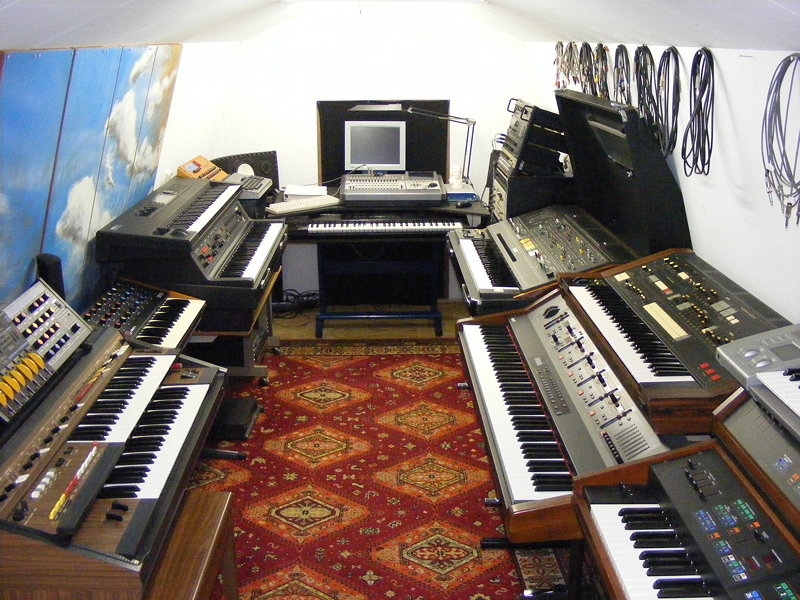



The Starship One project
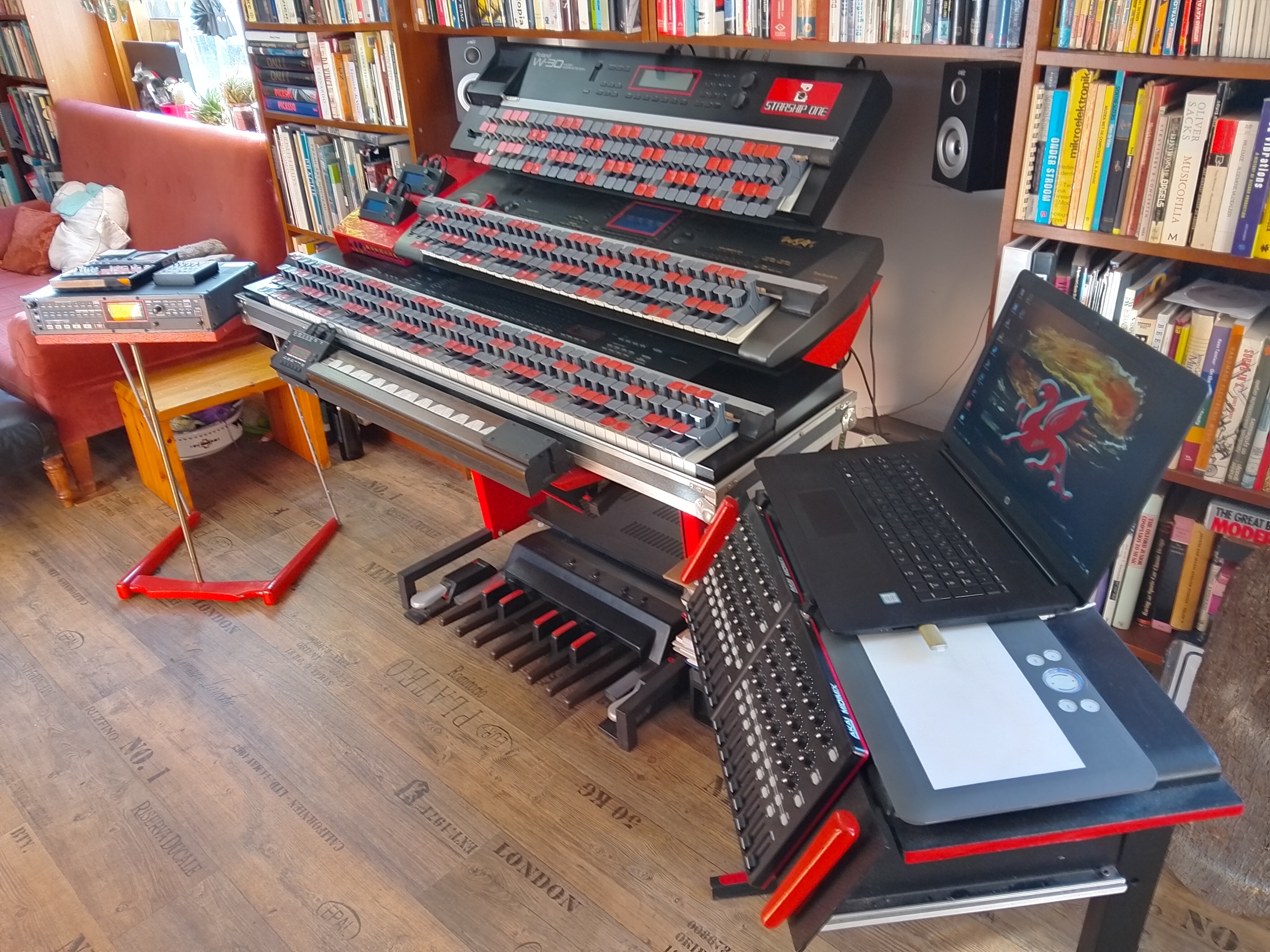
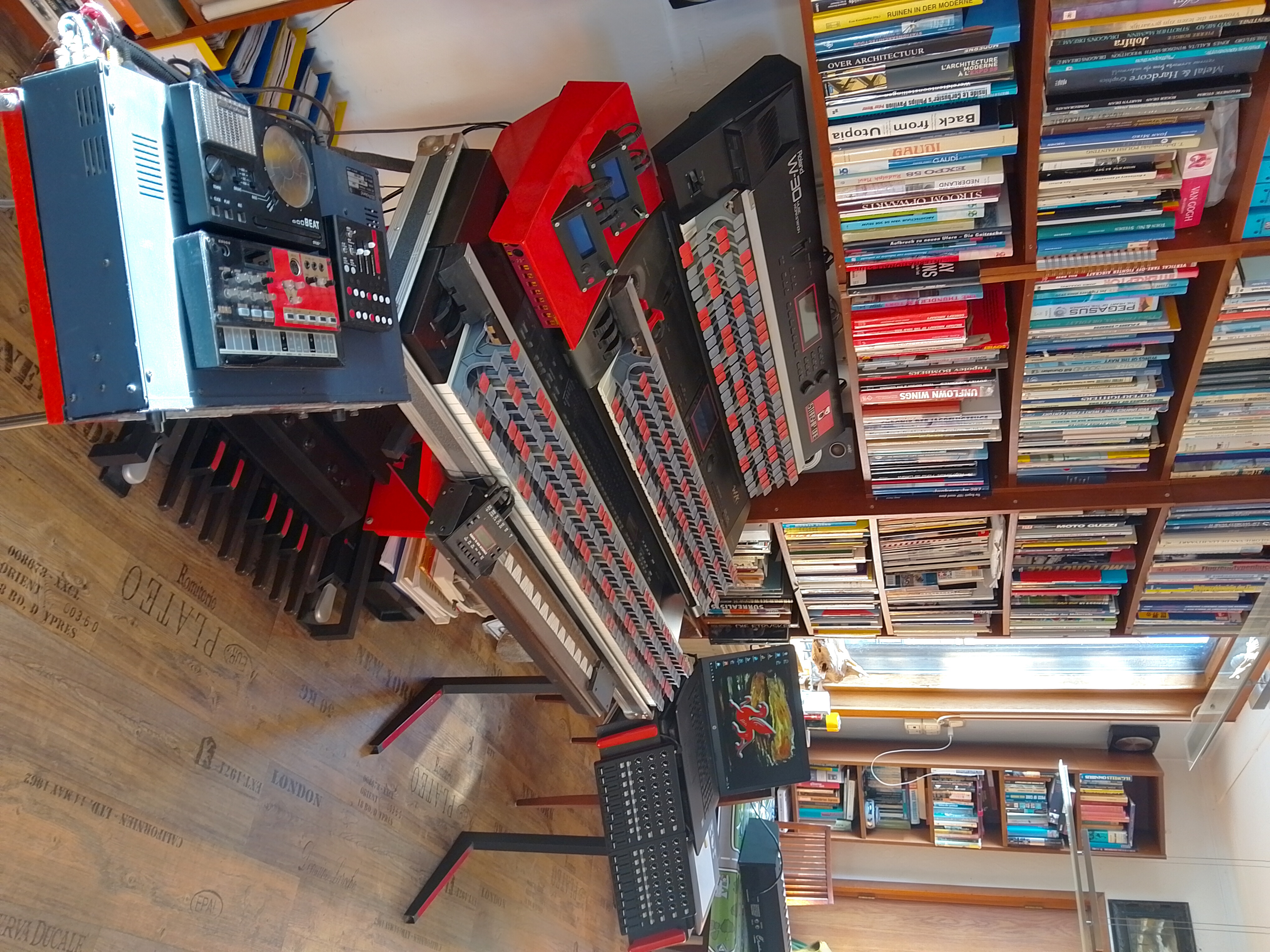
Starship One 2025 update
The Starship One setup keeps evolving. Sometimes in incremental steps. Sometimes with leaps. The version shown here has been archived as the 6th and even that is only a very crude categorization.
The latest news is that it now sports 3 keyboards, all carrying their own Janko adapters. So this ultimate mad professors infernal music machine has now reached almost caricaturist proportions but, as will be explained below, common sense is still hiding under the surface.
The changes since the previous website update are the following:


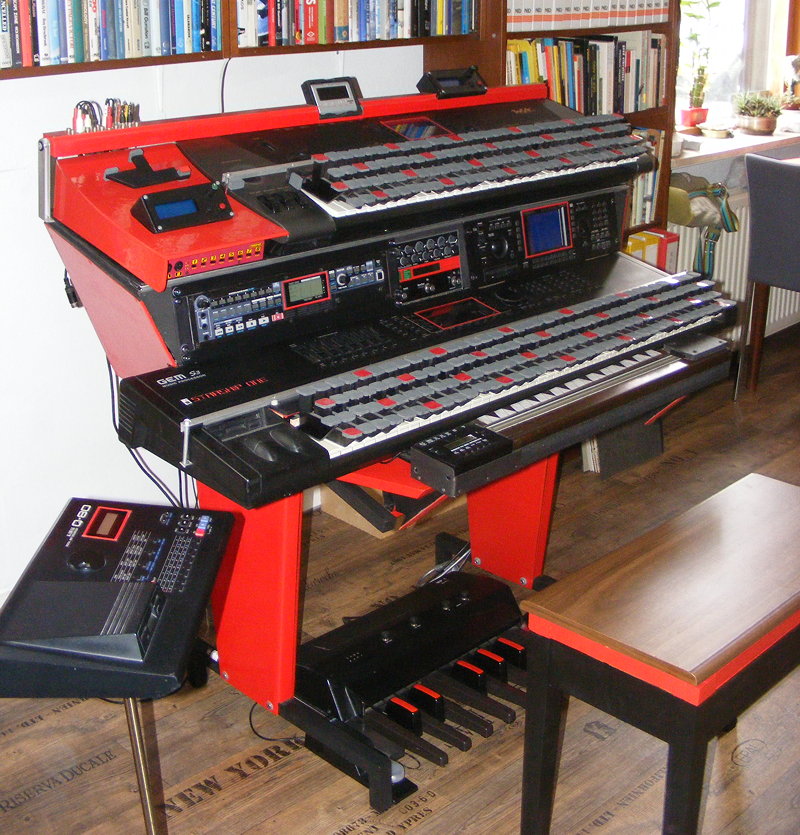
This is what the Starship One offers in its 2021 layout:
The latest addition to the Starship One is a rather strange and unique one. I designed and built 2 adapters that convert the existing piano type keyboards into so called Janko keyboards. The Janko layout has many advantages. Too many to discuss here but a new article has been added to the WRITING page. In it I explain all these advantages and also describe the whole design. So if you want to build your own personal weird piece of musical furniture this is your chance.
Yep, it certainly looks outlandish but it really works. I have also already composed new music on it. The project is called Chamber Music For Starships, which can be downloaded on the Electronic Music page, proving that these converters are not only intended to make the Starship One look like a SF movie prop. Commander Data from Star Trek: The Next Generation might actually (have) like(d) it if he did not have such a conservative taste in music.
A full set of articles describing my intentions and experiences with the Starship One project can be downloaded from the WRITING page.
The MIDIMIXFIX
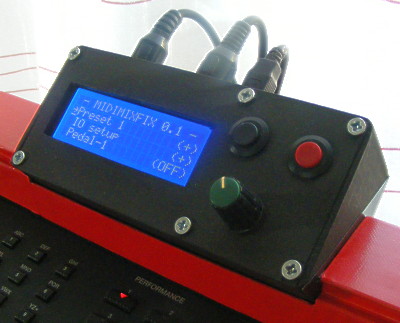 This little box adds real muscle power to any MIDI controlled system. Especially if you prefer stand alone instruments and do not want the hassle of adding a laptop or a computer to your setup.
This little box adds real muscle power to any MIDI controlled system. Especially if you prefer stand alone instruments and do not want the hassle of adding a laptop or a computer to your setup.
MIDIMIXFIX can be used to fix small discrepancies in MIDI data interpretation between two or more units in a MIDI setup. It can however also do some very complex things. Just one example: It can rewrite the MIDI information from a poly aftertouch generating keyboard into a data stream that makes about every multitimbral synth polyphonic aftertouch compatible.
That is quite a mouthful and the average keyboard player will probably say: "Er, what?", as will most DJ's and dance music producers. To those of us who still believe in expressive playing this can however be a little revolution.
So if you either have to fix some minor irritation or want to add incredible options of expression to your MIDI setup, this could just be what you are looking for.
The MIDIMIXFIX was designed and programmed by Lars Ole Pontoppidan.
For detailed information about what the MIDIMIXFIX particularly means to me see my article about the Starship One project
Yamaha "Son Of GX"
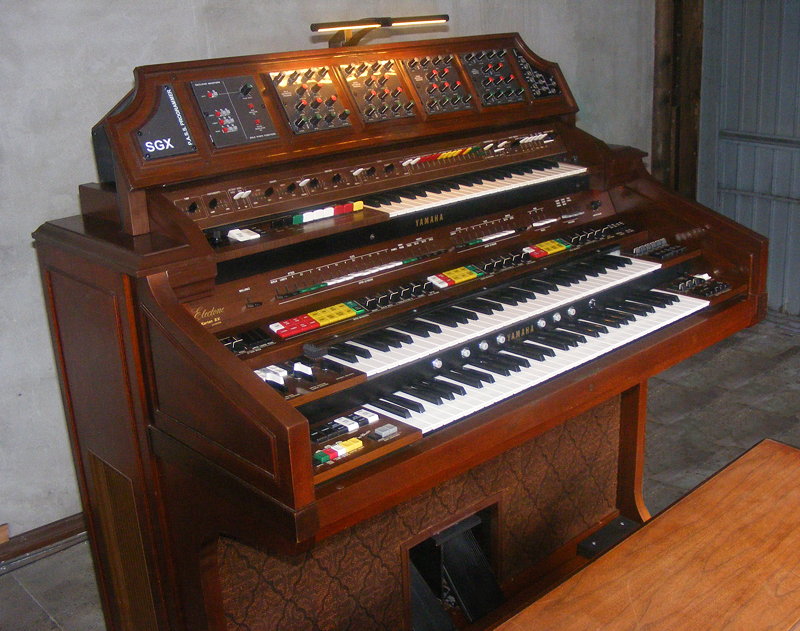
This is a heavily customized E-70 organ with the synth functions of all 3 orchestra sections (upper keyboard, lower keyboard, pedals) fully and independently programmable. Furthermore a 4th solo section has been added.
Although many people have compared converting Yamaha E-series organs into programmable synthesizers to turning them into CS80´s I have always looked much more towards the GX1 connection. The GX1 was the mother of all Yamaha CS´ and contained 1 analog solo synthesizer, 2 polyphonic sections and 1 bass pedal section. So how could the Son Of GX ever be really complete without the addition of such a solo synth?
I originally thought about converting an EX-1 but could not find one for reasonable money. So yes, theoretically this can still be outdone but on the other hand a personalized version like mine will be more unique. And more "compact". Even more homely.
Added to the V2 version:
In short: The Son Of GX has become even more expressive and capable of experimental sounds!
If only Kieth Emerson was still been around to play it! He actually could have since this thing already existed when he was still alive but it has, as always, taken me quite a while to also write about it and update the website. Whatever: Thanks for the great music and the inspiration, Kieth. If an Elysian field for artists exist you must be grazing there right now.
Customization guides describing the whole conversion process can be found on the WRITING page. For video evidence visit YouTube and type in "Marcjeparkje".
Although I am not entirely the first to do this, sharing my knowledge openly seems to have started a small trend. And the word is still spreading and although some suddenly forgot where they got the idea's and extra help from the moment they finish their project (I will not name any names here) others act more polite.
Jayson Tailor from the Great Lakes region of the U.S.A. is such a person. He still keeps in touch and even tries to do something in return. The photograph shows his version of the SON OF GX concept.
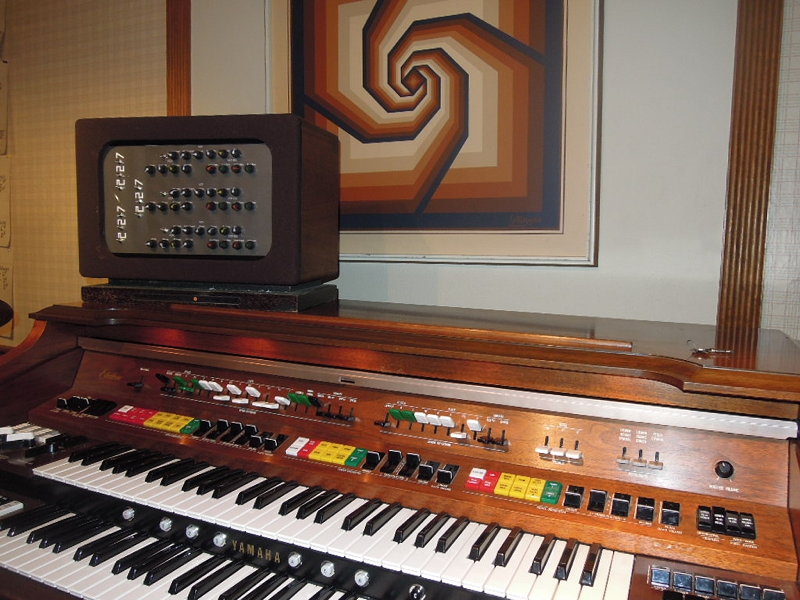
And yet another person has performed the original Son Of GX mod! Jacob Korn from Germany is the 4th person that I know of actually going the whole way. I have met Jacob personally and he is a very friendly guy.
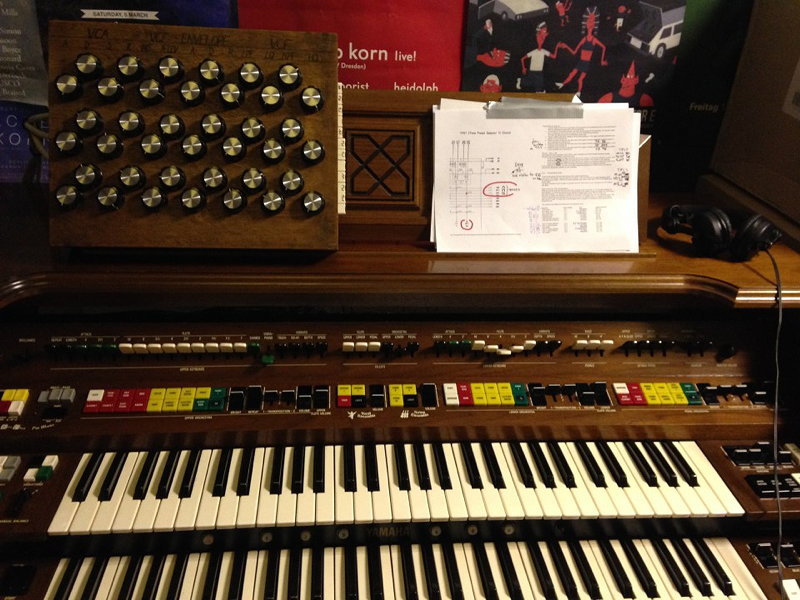
PolyCheesy GX 800
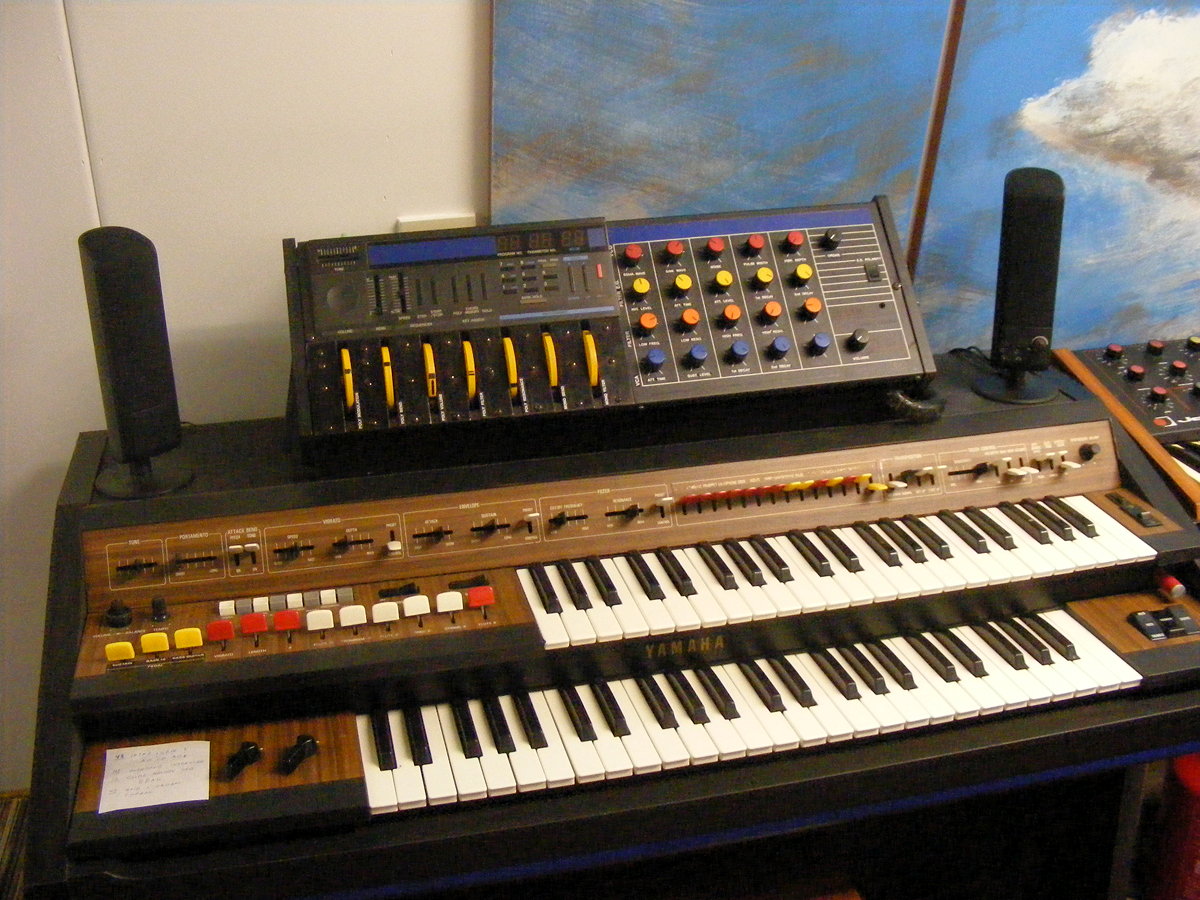
Yamaha CSY-1 with with monosynth made fully programmable and lower keyboard substituted for Korg Poly-800/2 with Moogslayer mod.
It´s a temperamental little beast though. It went down on me some time ago. Probably nothing drastic but where to find the time to cure it with so many new projects begging for time.
For video evidence visit YouTube and type in "Marcjeparkje".
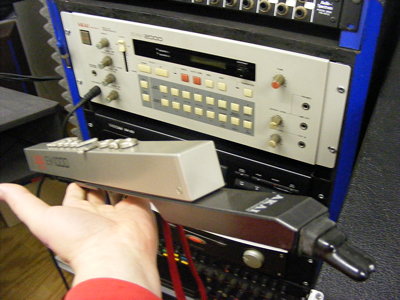 Akai EWI / EWV 2000 wind-synthesizer
Akai EWI / EWV 2000 wind-synthesizer
Derived from Niel Steiner's wind-synthesizers. A perfect instrument for solo's if you can live with its quirks. It contains a 2 VCO analog synth which is controlled via a woodwind type controller. It was my most expressive synth until I got the CS-80 (which see).
Alesis D-4 percussion-module
16 bit sounds but too artificial and polished for my taste. Nowadays I only use it as a padconvertor for my handbuilt electronic drumset (which see).
Crucianelli (Crumar) Compac Synth
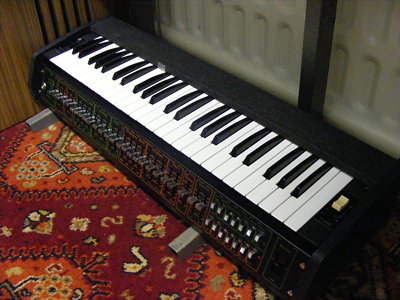 Somewhat of an enigma. It never seems to be mentioned in Crumar's history and actually isn't labeled as a Crumar but as a Crucianelli synth. It's that early! Some even expressed doubts if it was actually ever put into series production. This example proves just that.
Somewhat of an enigma. It never seems to be mentioned in Crumar's history and actually isn't labeled as a Crumar but as a Crucianelli synth. It's that early! Some even expressed doubts if it was actually ever put into series production. This example proves just that.
It's a basic machine but the concept is rather nifty. It has 2 completely independent voice channels, which can be layered on top of each other or put either side of a split point. The oscillators seem to be of a divide down organ type.
As such It reminds me of a mix between early Roland (oscillator functionality: SH-3) and early Korg (general layout: 700 series, concept: 800DV).
How it sounds? I've got no idea yet. It presently resides in the "still to be fixed" department. Ah well, at least it was priced accordingly.
Crumar 2003
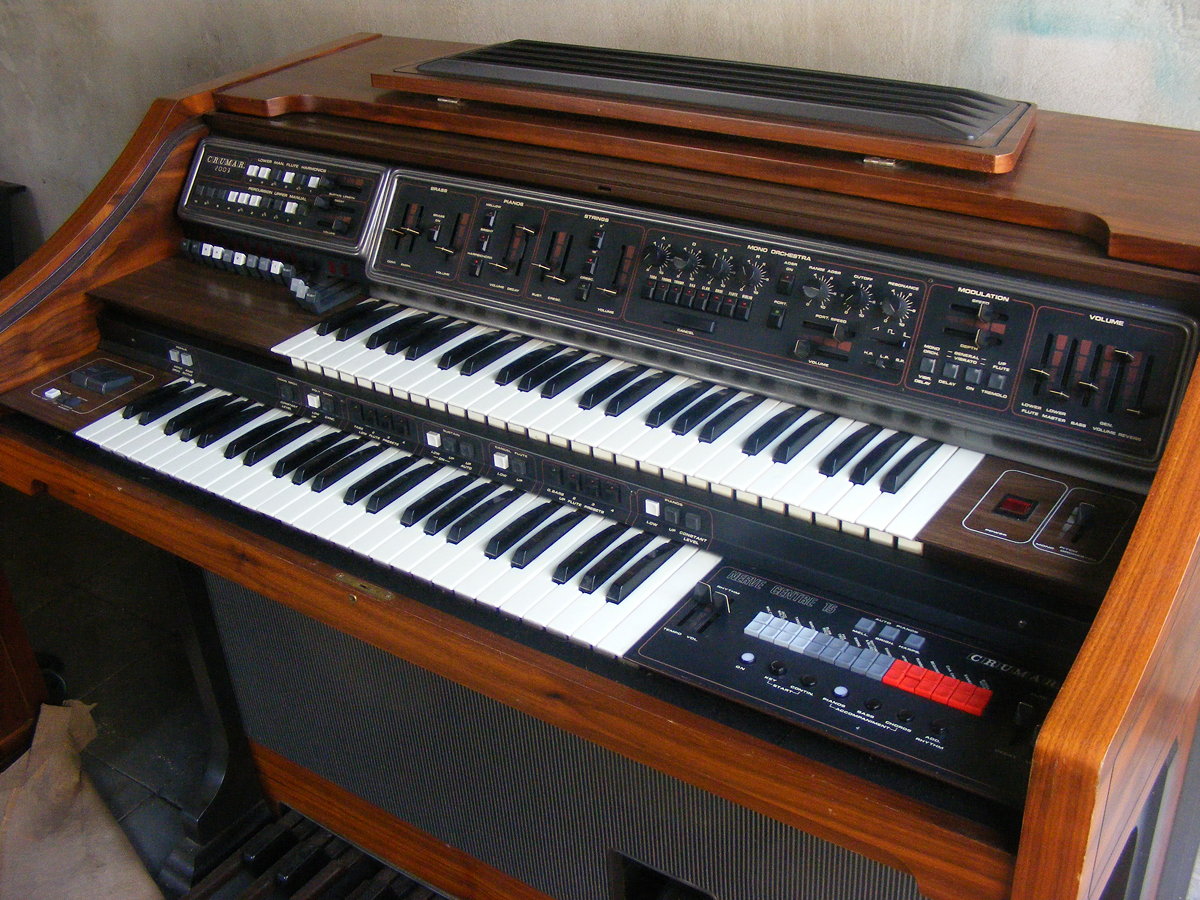 What! Have I gone bonkers? No? Why am I then constantly buying banged up old organs in stead of synthesizers? Well, for a big part because the prices for vintage analog synthesizers have become totally ridiculous. There is more though: For life performances the typical organ layout is actually a very good choice. Furthermore some of the organs of the late 1970´s and early 1980´s are rather interesting if one likes the aesthetics of electronic sound. Before that period organs always sounded somewhere between weedy and preachy. After it things became all FM or sample based, meaning that, just as with synthesizers, most instruments lost their individual characters.
The Crumar 2003 is a perfect example of this. It contains one of the best electronic, full drawbar, Hammond imitations. To this it adds a rather flexible one oscillator monosynth wit band pass filtering, a complete Crumar Multiman / Orchestrator, thus also adding paraphonic strings, very powerful brass sounds and even electric piano and chlavichord. The final element is a full Nerve Centre 15 drum and accompaniment section (the best of analog Italian Cheese). This makes it actually rather unavoidable to conclude that the resulting combination is a rather heady (and literally very heavy) combination.
What! Have I gone bonkers? No? Why am I then constantly buying banged up old organs in stead of synthesizers? Well, for a big part because the prices for vintage analog synthesizers have become totally ridiculous. There is more though: For life performances the typical organ layout is actually a very good choice. Furthermore some of the organs of the late 1970´s and early 1980´s are rather interesting if one likes the aesthetics of electronic sound. Before that period organs always sounded somewhere between weedy and preachy. After it things became all FM or sample based, meaning that, just as with synthesizers, most instruments lost their individual characters.
The Crumar 2003 is a perfect example of this. It contains one of the best electronic, full drawbar, Hammond imitations. To this it adds a rather flexible one oscillator monosynth wit band pass filtering, a complete Crumar Multiman / Orchestrator, thus also adding paraphonic strings, very powerful brass sounds and even electric piano and chlavichord. The final element is a full Nerve Centre 15 drum and accompaniment section (the best of analog Italian Cheese). This makes it actually rather unavoidable to conclude that the resulting combination is a rather heady (and literally very heavy) combination.
One could actually prove the point by recording a complete Berlin School space music album with it alone. Maybe I will, one day. Just to prove the very point. After first having refurbished this beast of course.
How then can it be that nobody is aware of this instrument and that the few that exist can be had for next to nothing (mine cost only the transport costs and a bottle of whine) but a good standalone Crumar Multiman / Orchestrator, which could be considered to be only one quarter of this whole, is nowadays already moving towards the 1.000 Eu / 1.200 US$ mark? It´s mad, mad world.
DKI Synergy II+ with Kaypro 4 computer and editing software
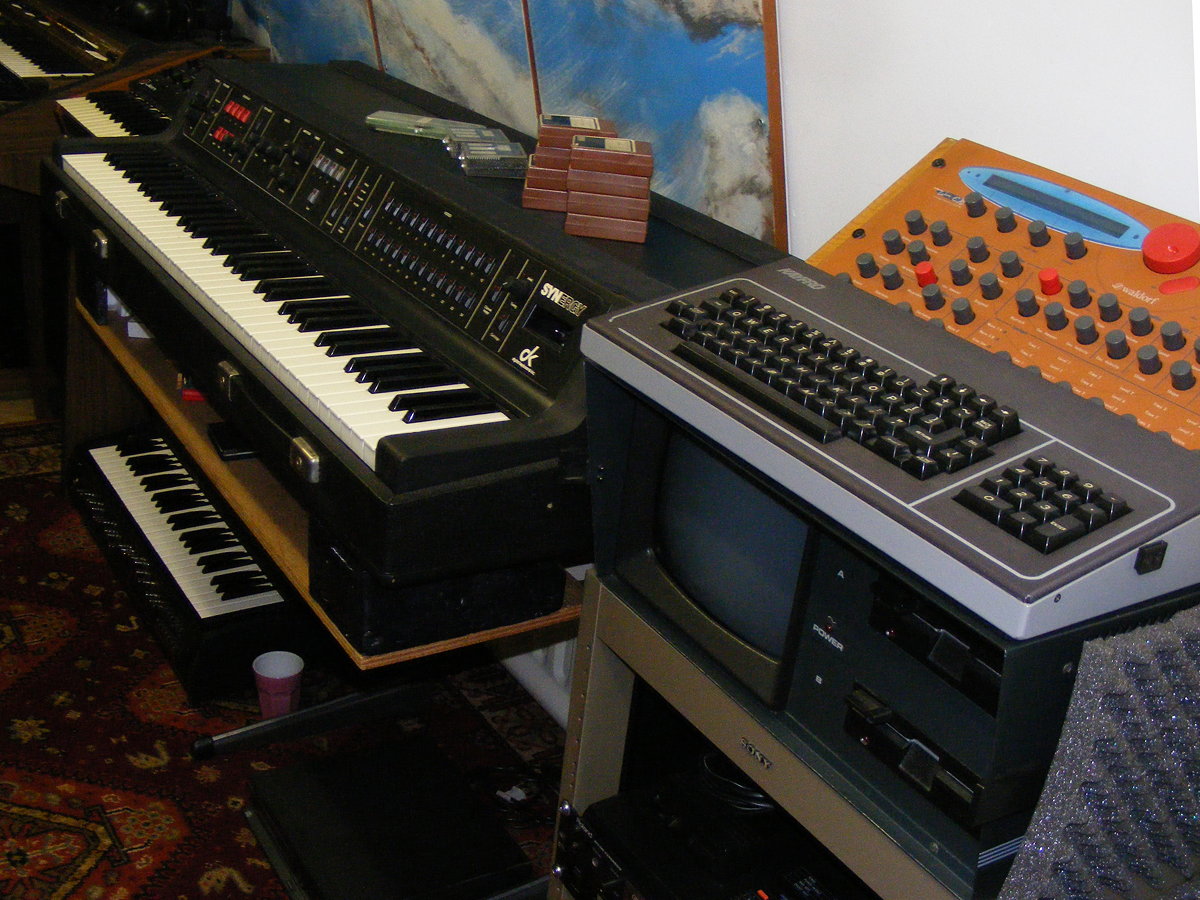 The Crumar / DKI GDS was one of the grand early computer synthesizer systems. Only few where built but luckily there is an alternative. The Synergy originally was a preset version but this set has the same sonic capabilities as the GDS. Even the presets sound fantastic and I am dying to start programming it's additive and AM engine. It has it's quirks though. The computer is hilarious anyway! It's an early 80ties portable with a tiny green screen.
The Crumar / DKI GDS was one of the grand early computer synthesizer systems. Only few where built but luckily there is an alternative. The Synergy originally was a preset version but this set has the same sonic capabilities as the GDS. Even the presets sound fantastic and I am dying to start programming it's additive and AM engine. It has it's quirks though. The computer is hilarious anyway! It's an early 80ties portable with a tiny green screen.
Doepfer R2M ribbon controller
I have been diving quite deep into the history of electronic and experimental music during the last few years. Learning more about early instruments like the Trautonium and the Ondes Martenot made me want to move in this direction, if only to expand on the possibilities of the standard electronic keyboard interface.
The R2M is very nice and affordable option. It might not be so bright and shiny (and expensive) as the Hakan Fingerboard but as a monophonic controller it is quit effective.
I even wrote an article with tips to "Pimp it up" for better use as a keyboard alternative. It's included on the WRITING page already. Have fun.
At the moment I am practicing endless Paganiniesque violin solo's and mournful Duduk wailings. Keep your eye on the MUSIC page for the results. If you dare!
Also see the Starship One project.
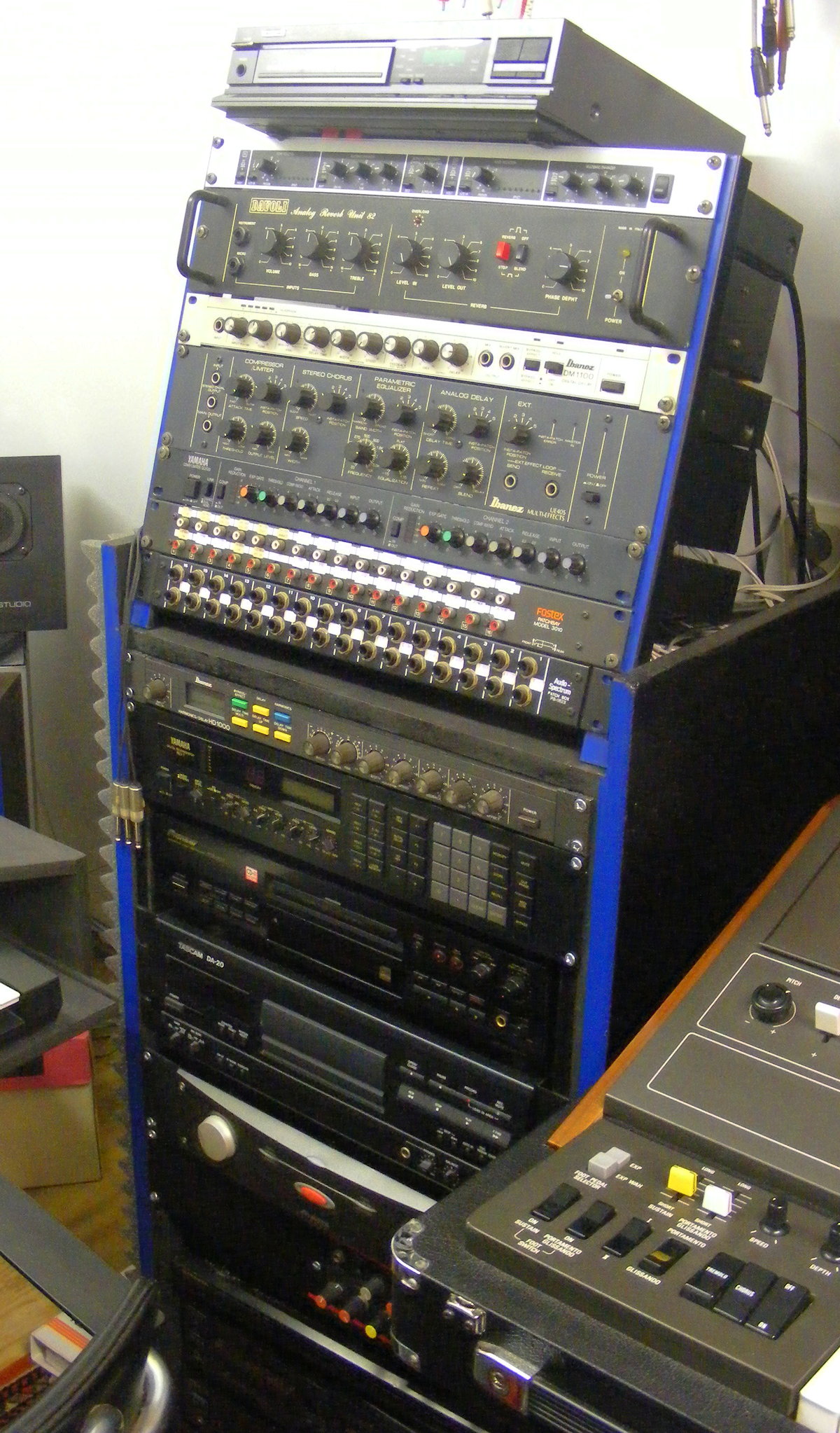 Effects rack
Effects rack
Filled with not very sought after but perfectly useable vintage gear. Some examples: Ibanez UE-405 analog multieffects processor. Yamaha REV-7 early digital reverb. Davoli stereo spring reverb (My first reverb but still the best spring reverb I have ever heard!).
Elka X30
At the time of it´s introduction in the 1980´s I used to loath this sort of instrument. Synthesizers where the real thing for me. Organs where something for old has-beens. How wrong I was. In real life the line between organ and synthesizer technology became ever more blurred. This is a perfect example for that era. It may not offer full preset programmability but it still sounds surprisingly good. If you do not take the classical preset names too seriously there actually is no terrible sound in earshot. Kitschy maybe but never truly bad. It all sounds like a near perfect mix between digital precision and analog character. No wonder Elka´s Synthex has such a strong reputation. After this Elka mainly switched over to 4 operator FM. They actually implemented it with a more musical ear then Yamaha itself but even then a lot of character was lost.
The X30 still came from the right side of that divide.
The analog choir sound is actually one of the best ever, not as bleakly cold as that of Roland´s VP-330 but certainly as perfectly robotic. Furthermore: The typical 8-bit sample, synthpop-type drum sounds by now sound perfectly (while at the time we all thought: "Nah, could still be a lot better.") and the user can even program his own patterns. The only letdown are the organ sounds themselves. They have the same semi-digital warmth but could never be mistaken for a grumpy Hammond. In that respect the earlier Crumar 2003 (which see) faired a lot better.
Eventide Modfactor
It might seem just another effects box but this crazy thing with its ability to modulate modulation sources is a sure fire solution to turn every mediocre synth or keyboard into a modulation fiend. I love it although I try to only use it sparingly. It would be too easy to fix about everything with it.
Farfisa Syntorchestra
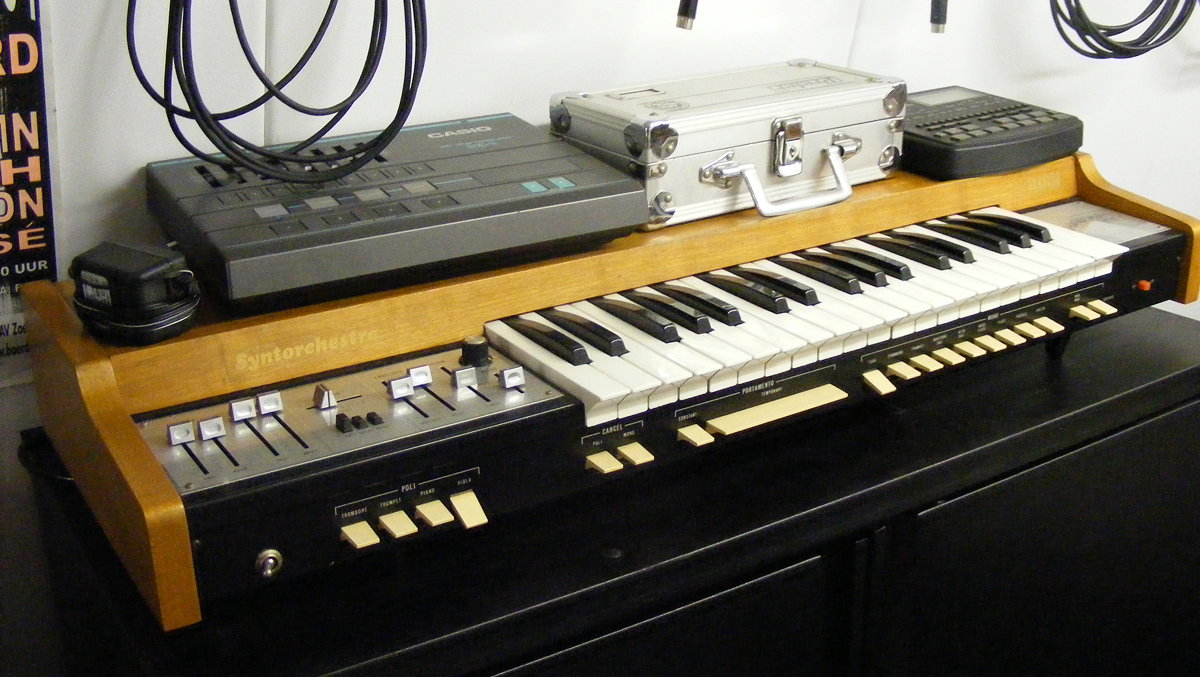 It might look like just another cheap organ sling-on but looks deceive. This is a very musical multi-keyboard instrument.
It might look like just another cheap organ sling-on but looks deceive. This is a very musical multi-keyboard instrument.
OK, the poly section is paraphonic and none of the sounds can be called very convincing when heard in isolation. The same applies to the monosynth that can be layered on top. Still the layered results somehow sound far above average.
In that respect it can be called the absolute antithesis of the Yamaha SK50D (which see). The SK50D provides access to a lot of parameters but sounds average when not treated expertly. This Syntorchestra however has the barest essentials but can sound excellent from the word go. No wonder that some well known names, like Vangelis and Klaus Schulze, used it before real polyphonic synthesizers became affordable / available.
By the way: I have been told that the electronic design is also rather unique.
Furthermore: Calling it a Syntorchestra in stead of a Synthorchestra is actually not a typo. Its really the name that those Italians gave it, probably because their word for synthesizer is "sintetizzatore". But why still use the "y" then? On the other hand the poly section is called "poli". Doh! Let´s face it: Even today the Italians are still better at designing stuff then talking English. Do however not get me wrong. This list does after all prove that I absolutely love Italian stuff!
Seriously though: Do not underestimate this peculiar little gem.
GEM Promega 3
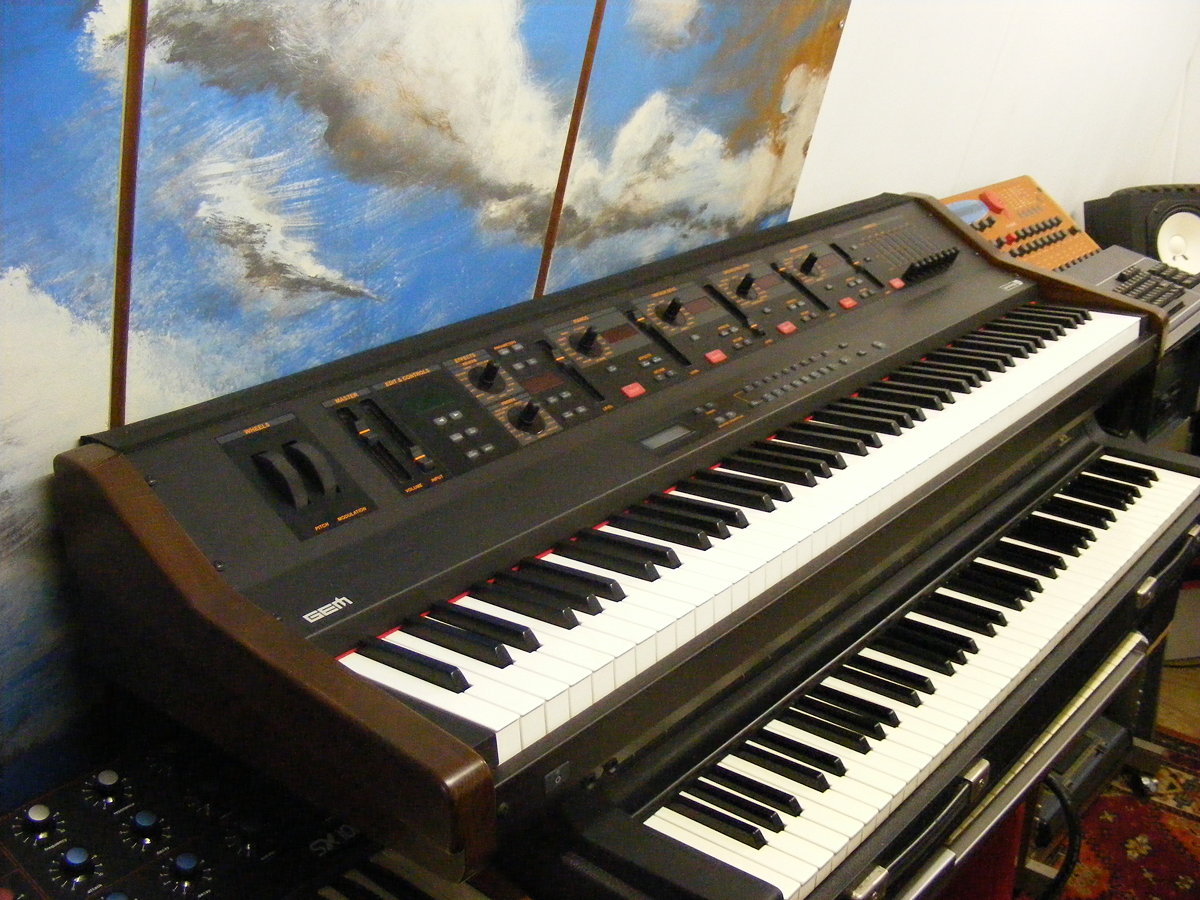 Still an excellent virtualy modelled / sampled piano that is as good as indistinguishable from the real thing. It might not have the dynamic range of other digital piano's but one typically always puts a compressor on a piano track anyway. Furthermore it is very good modern interpretation of the old, much underrated multi-instrument theme. 4 Layers can be mixed very intuitively.
Still an excellent virtualy modelled / sampled piano that is as good as indistinguishable from the real thing. It might not have the dynamic range of other digital piano's but one typically always puts a compressor on a piano track anyway. Furthermore it is very good modern interpretation of the old, much underrated multi-instrument theme. 4 Layers can be mixed very intuitively.
O.K. It is not fully programmable so it will be outperformed by any modern workstation on paper but it can still make some rather adventurous sounds, is always musical, has an ergonomic, space age (almost) one knob per function design, motorized faders, blinking leds that match the red of the felt ribbon above the keyboard etc.. One has to be blind an deaf to not like it as far as I am concerned.
GEM S3 Turbo
Normally a workstation does not get on my wishlist anymore. In the past I was very happy with such versatile machines but nowadays I can afford to choose machines purely for their special abilities and / or character. Why the S3 then? Well, first of all it has polyphonic aftertouch. Secondly it is a very versatile sample based virtual analog. But there is more. It has 7 real time control sliders, can import WAV-samples, has nifty stereo panning options, a good MIDI-recorder etc. etc. etc. Just forget about it's apparent everymans friend concept and the unpopularity of the GEM brand. Even if you never use the workstation options, this is a serious synthesizer and a worthy sibling to the Promega 3.
Presently I am converting the CS80's raw waveforms into a sample set. The reason: When the CS80 totally packs up one day I'll at least have a very reasonable substitute. And it should also be a perfect match to the Waldorf XT which is said to be able to process polyphonic aftertouch data. I still have to check that out though.
So is it perfect? No. It's a pig to program. The original user guide is 304 pages long and the user interface totally counterintuitive!
Also see the Starship One project.
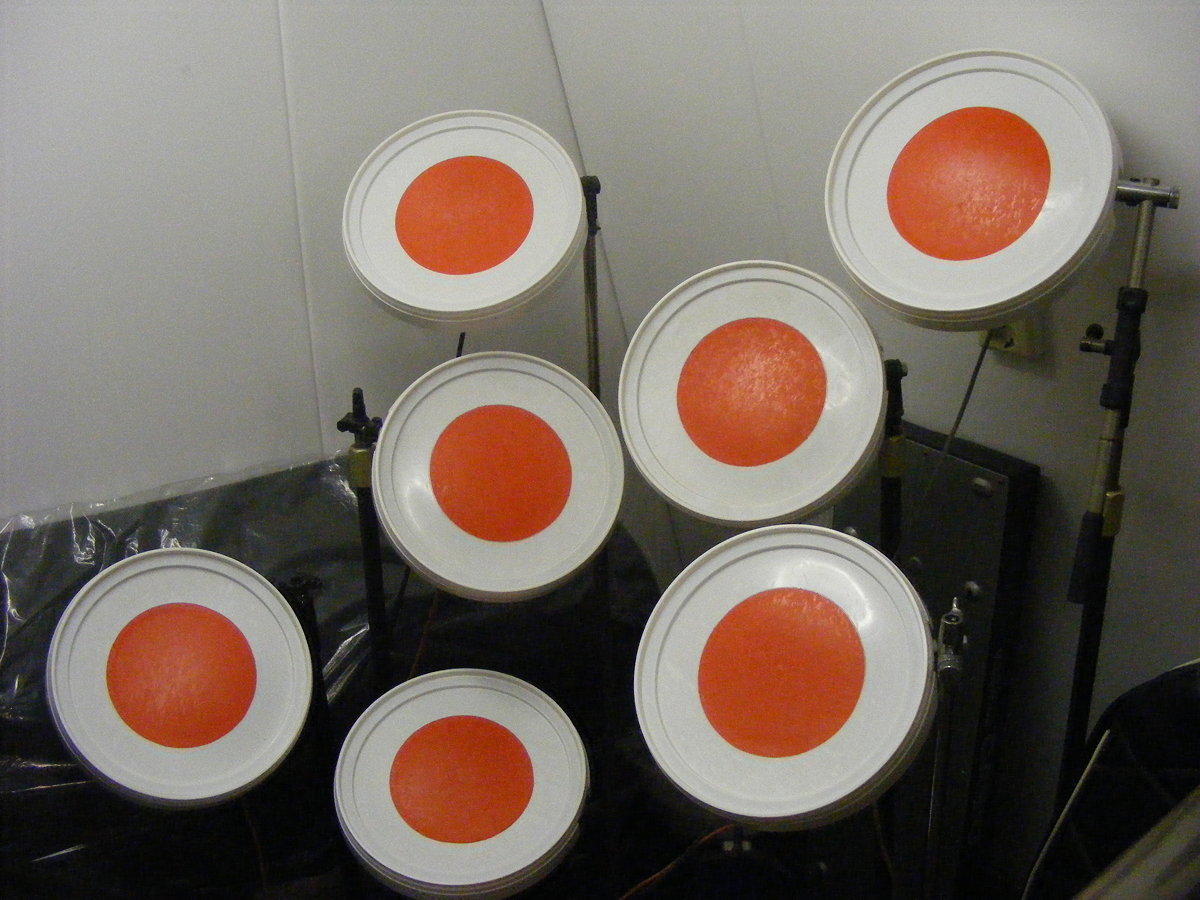 Handbuilt electronic drum set
Handbuilt electronic drum set
Made out of old mayonnaise bucket's and telephone microphones (I am not kidding!). It's by no means comparable to a professional solution but still is surprisingly usable.
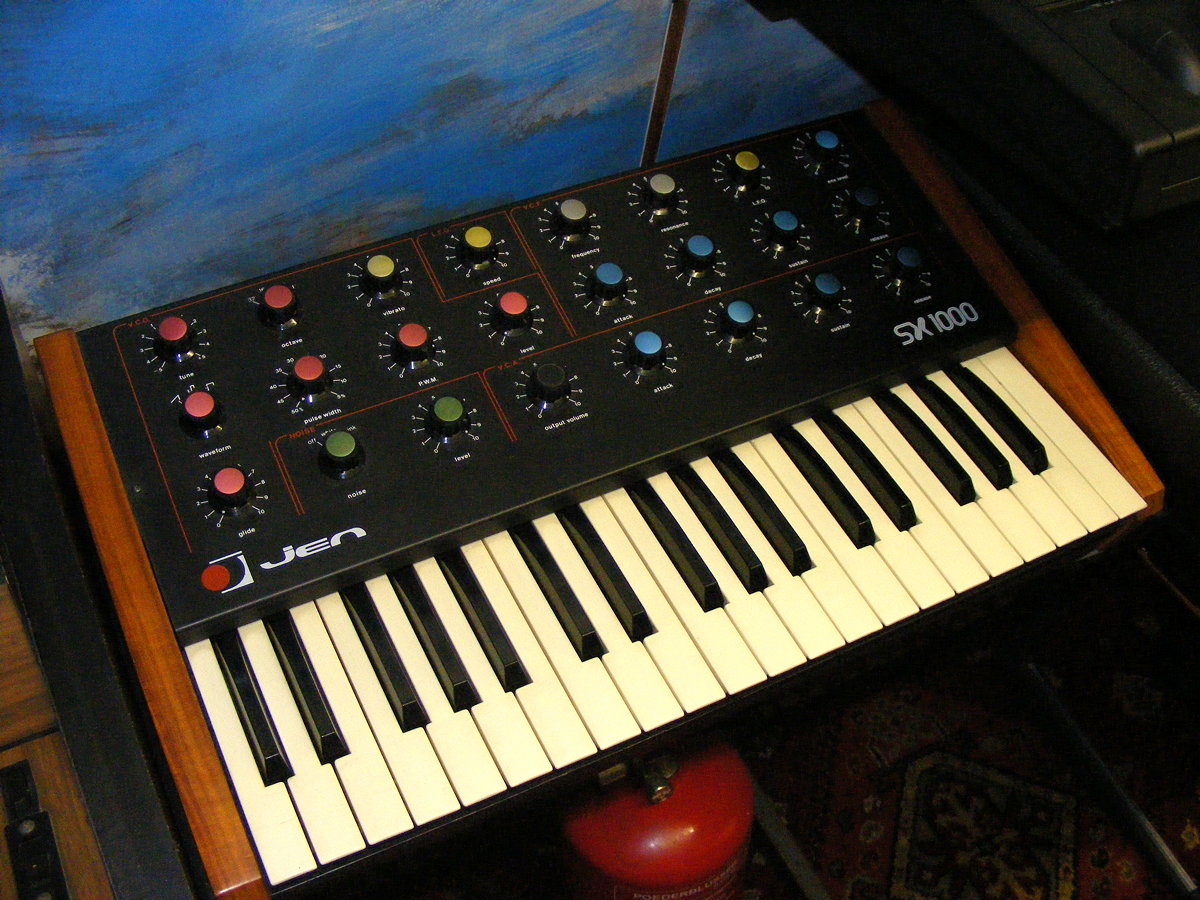 Jen SX-1000 synthesizer
Jen SX-1000 synthesizer
Vintage monosynth from Italy. Only 1 VCO and noise, no sync or ring mod, only a single LFO but 2 full ADSR's. It should however not be underestimated. It has a very powerful sound for a single VCO synth. I still use it regularly. I especially love its trebly basses that can stand out clearly in a dense track. And its pink noise swooshes. Instant analog synth surf.
Kawai Q80 sequencer
Since the WSA's internal sequencer proves to be a total bug ridden dud that stands in marked contrast to it's excellent synthesis section I do not consider it to be a valid tool. As so often before I have contemplated switching to a DAW computer program but one of those typical computer crashes has kept me from joining the "Dark Force" once again.
The Kawai Q80 might not provide helpful visual aids like piano roll editing but it is a fully fledged 32 track MIDI sequencer, driven by a clear matrix oriented menu structure and all the essential micro editing fascilaties. Furthermore it can record up to 16 tracks in one go (!). For the multitrack recorder type approach without too much reliance on detailed editing it is a very good tool and like all hardware it is very stable and reliable. A nice surprise.
Korg Prophecy
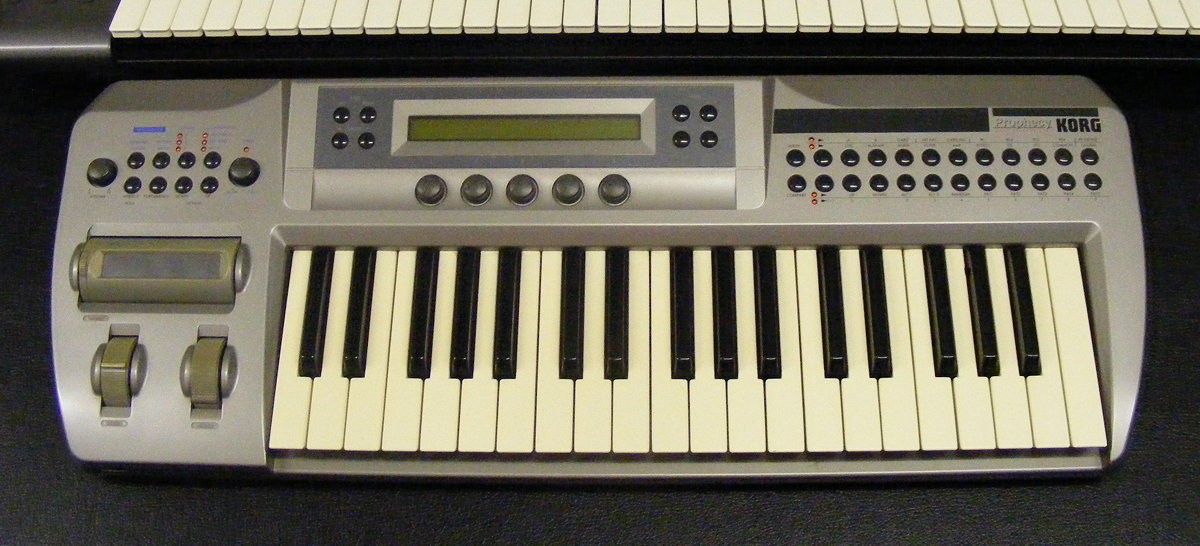 So I sold my Z1 to buy a Prophecy only a few months later. I still think it 's a good trade off though. The only thing I really missed from the Z1 was it's almost perfect electric solo guitar emulation, which surprisingly is not dependent on physical modeling but on the on board effects. The Prophecy is only mono but since guitar solo's tend to be monophonic anyway it's a perfect replacement which I got hold of for a very reasonable price.
So I sold my Z1 to buy a Prophecy only a few months later. I still think it 's a good trade off though. The only thing I really missed from the Z1 was it's almost perfect electric solo guitar emulation, which surprisingly is not dependent on physical modeling but on the on board effects. The Prophecy is only mono but since guitar solo's tend to be monophonic anyway it's a perfect replacement which I got hold of for a very reasonable price.
Oh boy, I am really entering one instrument per sound territory nowadays. What decadence.
By the way: For the financial difference I bought an immaculate WSA1 as a backup for the one in the Starship One. Obsessed? Me?
Rhodes Chroma with Expander
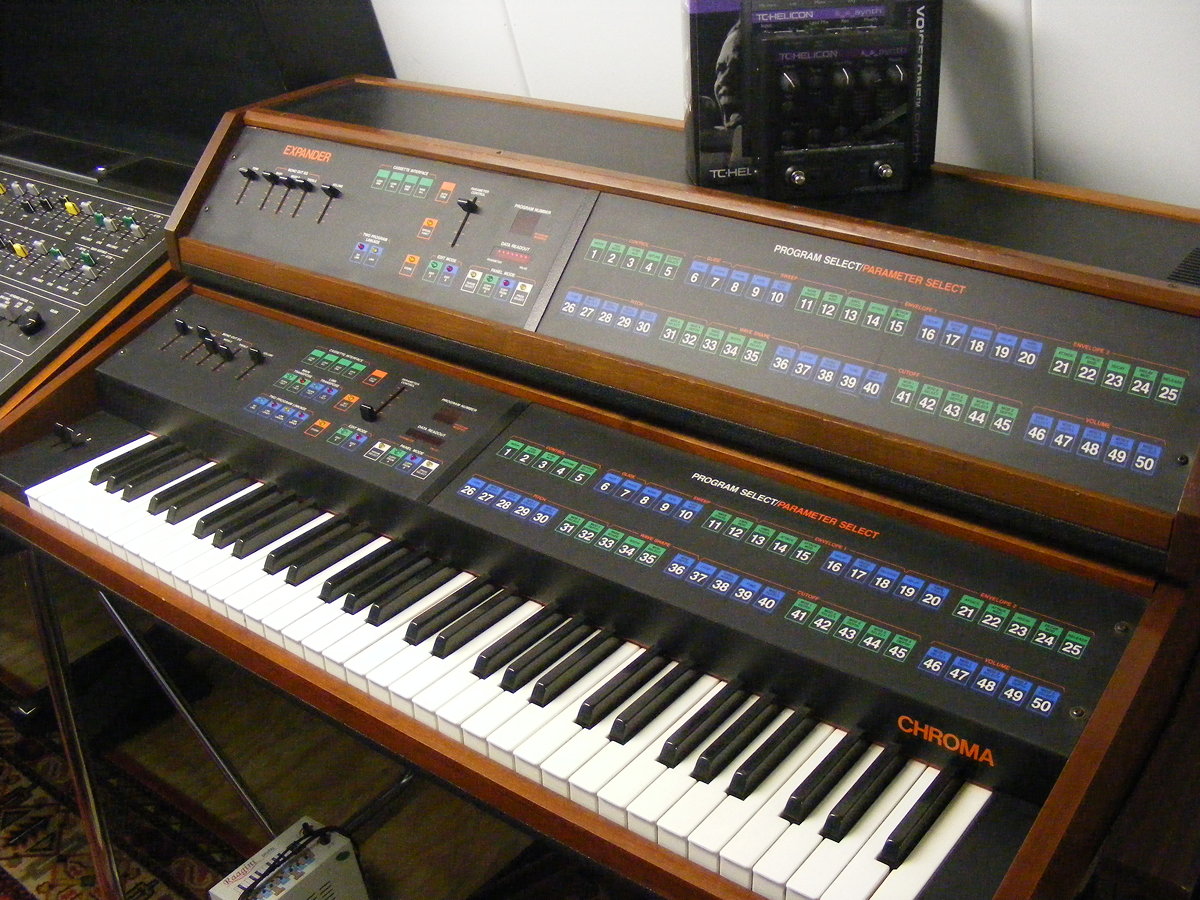 Another true vintage synth and very rare piece of equipment. Especially the expander is quite unique. The design is analog, polyphonic, semi-modular through electronic algorithms and the sound is beautiful. So why do I not use it often? It's a pig to program and very unreliable. At the moment the Chroma works most of the time but the Expander not at all. They say the only real cure is to build in new power supply. Maybe I'll find the time someday but then there still is that ghastly DX-7 type user interface.
Another true vintage synth and very rare piece of equipment. Especially the expander is quite unique. The design is analog, polyphonic, semi-modular through electronic algorithms and the sound is beautiful. So why do I not use it often? It's a pig to program and very unreliable. At the moment the Chroma works most of the time but the Expander not at all. They say the only real cure is to build in new power supply. Maybe I'll find the time someday but then there still is that ghastly DX-7 type user interface.
I guess it's the ultimate collectors synth. It's the ARP that escaped alright! And what an ARP, the first truly polyphonic one. Because of its semi-modular architecture it can even be considered to be a sort of polyphonic 2600. It surely does sound similar.
There also are just enough semi-seminal albums to prove these claims, ranging from Jethro Tull to Joe Zaniwul and Chick Corea. Furthermore I personally still consider it to be one of the best looking machines ever, only to be surpassed by the SK50D (which see).
Actually owning one drags you back to a harsher reality though. It's just the worst combination of an 80ties counter-intuitive programming interface (membrane switches and only one fader) and unreliability. Even when new they constantly broke down. In that respect it's even a lot worse then the Yamaha CS80, which actually works quite well as long as you take care of some basic "rules of respect". Not so with the Chroma. It cost me Eu 300 to repair and it still is a royal pain in the ass.
So this one is only for the real die-hard connoisseur.
Riha Orchestra with Wersimatic
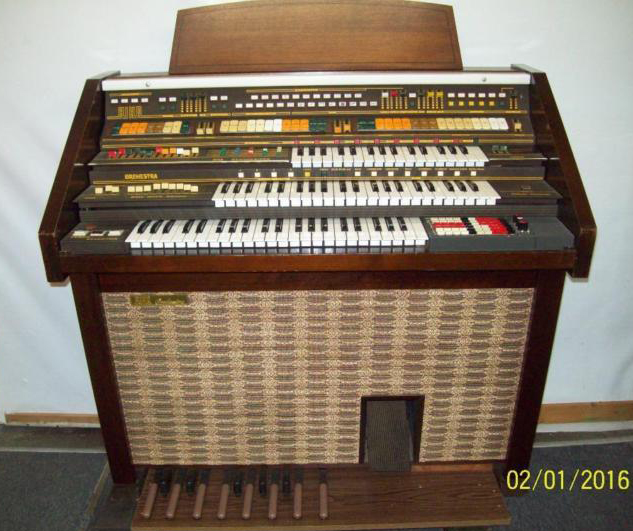 Those who have read about my Son Of GX project are aware I am rather into customizing old Yamaha organs into fully programmable synthesizers. Like all my organ oriented stuff these are from the period when the transition from analog to digital technology took place.
Those who have read about my Son Of GX project are aware I am rather into customizing old Yamaha organs into fully programmable synthesizers. Like all my organ oriented stuff these are from the period when the transition from analog to digital technology took place.
The Yamaha D85 would have been an even better donor then the E70 if it had not been too digital already, making it impossible to crack its preset programming facilities.
What does that all have to do with this beasty? Well, the Orchestra was the top of the line instrument from former Dutch organ builder RIHA. It sports the classical top of the line setup of 2 main manuals and pedals combined with a separate solo keyboard driving a monophonic synthesizer. So one could call it the dutch D85 (although future investigations might reveal that it is still a lot more analog).
Anyway: The solo synth on the Orchestra has some rather decent specs for a single oscillator synth (bandpass filtering for instance) and reminds one of the one on Crumar 2003). The non-organ poly sounds are quite reasonable and the strings are rather good. They actually come nearer to the sound of a real string section then most late 1970´s swirly, over processed string ensembles.
Customization bonuses on this particular example are the German Wersivoice, an electronic stereo Leslie simulator with a strong reputation, and an extra versatile Wersimatic accompaniment section. Speaking of the latter: This sort of stuff always gives me the feeling it is based on one single (probably Italian) design. The Wersimatic produces about the best analog drum sounds ever on top of that. It even blows the Roland TR 808 out of the water as far as the sounds are concerned (although it is, sadly enough, not fully programmable). It´s even stereophonic, which was still a big thing at that time!
These modifications might make this combo less collectible to die-hards but since nobody wants to pay good money for organs anyway that is hardly a relevant consideration (yet?).
Why I bought it? Simply because it is a good instrument that deserves to be saved.
Roland MOC-1
Sound Module with excellent orchestral sounds. One should skip the internal reverb though.
Roland SH 2000
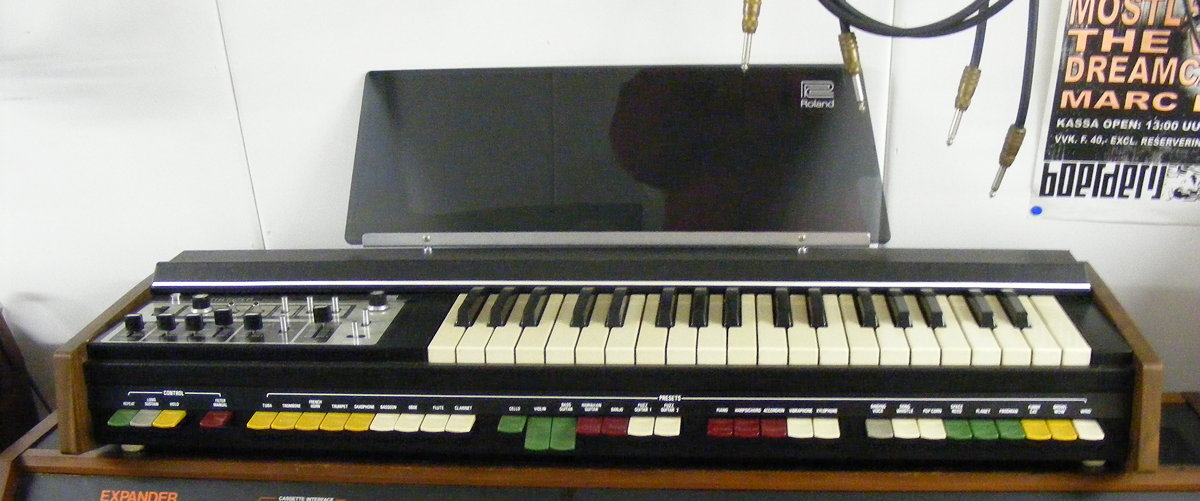 Another high ranker in the “Most Underestimated Synth Ever” list. On the surface this is just one of those nasty old preset, organ expansion analog synths. But it has a very well implemented aftertouch and some extra's that make it much more then that. It's SO expressive when you get the hang of it! And it can even do more vague, experimental stuff. One could fill a whole spaced out analog synth album with it and some quality effects only. Maybe I should write another article about it.
Another high ranker in the “Most Underestimated Synth Ever” list. On the surface this is just one of those nasty old preset, organ expansion analog synths. But it has a very well implemented aftertouch and some extra's that make it much more then that. It's SO expressive when you get the hang of it! And it can even do more vague, experimental stuff. One could fill a whole spaced out analog synth album with it and some quality effects only. Maybe I should write another article about it.
Roland VS 2480
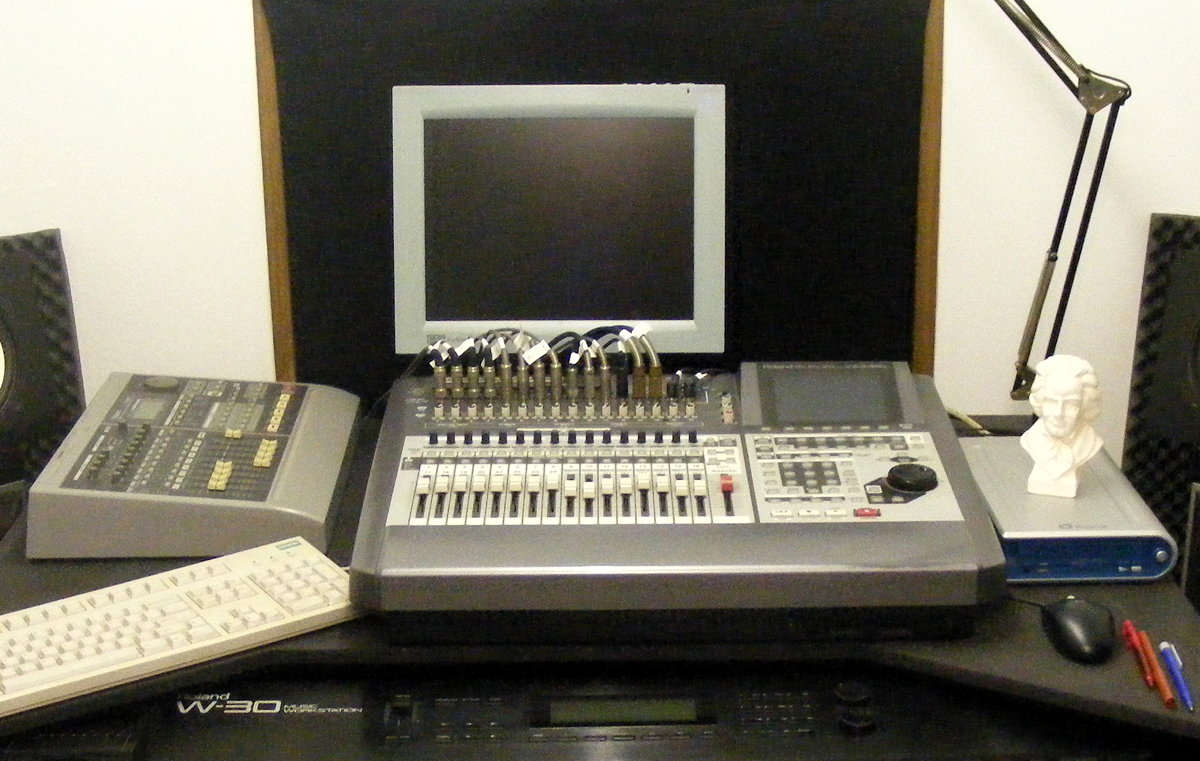 24 track digital recorder. For full track count you need to use Rolands own compressed data-format so more modern systems in theory deliver a higher audio quality. This still sounds better though then any old professional analog recorder so why change over to some unstable computer based system? It's strengths are that it combines a modern user interface (monitor, mouse, keyboard) and total recall (motorized faders even!) with the sturdiness and stability of a user dedicated system. To me that is the best of both worlds.
24 track digital recorder. For full track count you need to use Rolands own compressed data-format so more modern systems in theory deliver a higher audio quality. This still sounds better though then any old professional analog recorder so why change over to some unstable computer based system? It's strengths are that it combines a modern user interface (monitor, mouse, keyboard) and total recall (motorized faders even!) with the sturdiness and stability of a user dedicated system. To me that is the best of both worlds.
Furthermore it is not only a recorder to me but also one of my most important musical instrument. I typically start with left brain improvisations and then turn these in structured music by detailed right brain editing.
Roland VS-880
Being a rack mount 8 track audio harddisk recorder with integrated mixer the VSR-880 provides a fully integrated solution for mixing all individual outputs in the Starship One. Synchronized and combined with the Q80 sequencer it thus adds and almost limitless recording environment.
Roland W-30 sampling workstation
![]() Not very collectable but it used to be my major workhorse. It combines a multitimbral sampler with a midi-sequencer. So it's a bit of a low cost Fairlight. Besides providing typical studio quality samples I have also built up a very big catalog of my own samples. Which makes it very hard to replace in spite of its limitations.
Not very collectable but it used to be my major workhorse. It combines a multitimbral sampler with a midi-sequencer. So it's a bit of a low cost Fairlight. Besides providing typical studio quality samples I have also built up a very big catalog of my own samples. Which makes it very hard to replace in spite of its limitations.
TC Helicon Voicesynth
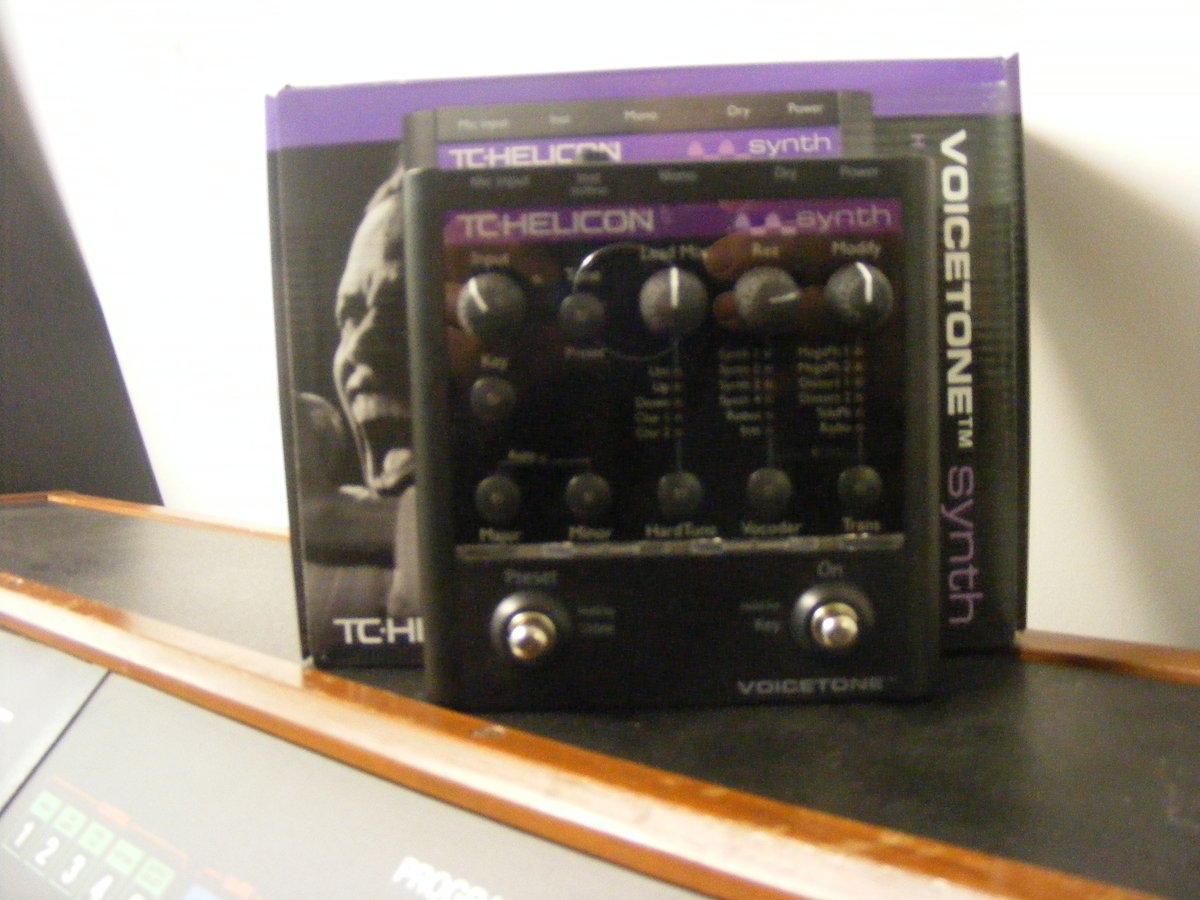 Why is a stompbox specially mentioned here? It's an old dream of mine to directly control synths with my voice to get to the most direct brain to sound interface possible. This combines auto-tune with synth and vocoder functions. I have been waiting for years for something like this and it's amazing! Now at last I've got an almost direct connection between my brain and my studio. I just sing and it delivers! It follows every performance subtlety in your performance. And one can immediately hear the difference. All my personal keyboard cliches have been sent overboard! It only has one little drawback: It does not reproduce vibrato´s and bends. But on the other hand. It instantly turns every bend into a perfectly tuned arpeggio.
Why is a stompbox specially mentioned here? It's an old dream of mine to directly control synths with my voice to get to the most direct brain to sound interface possible. This combines auto-tune with synth and vocoder functions. I have been waiting for years for something like this and it's amazing! Now at last I've got an almost direct connection between my brain and my studio. I just sing and it delivers! It follows every performance subtlety in your performance. And one can immediately hear the difference. All my personal keyboard cliches have been sent overboard! It only has one little drawback: It does not reproduce vibrato´s and bends. But on the other hand. It instantly turns every bend into a perfectly tuned arpeggio.
Technics WSA-1 and WSA-1R expander
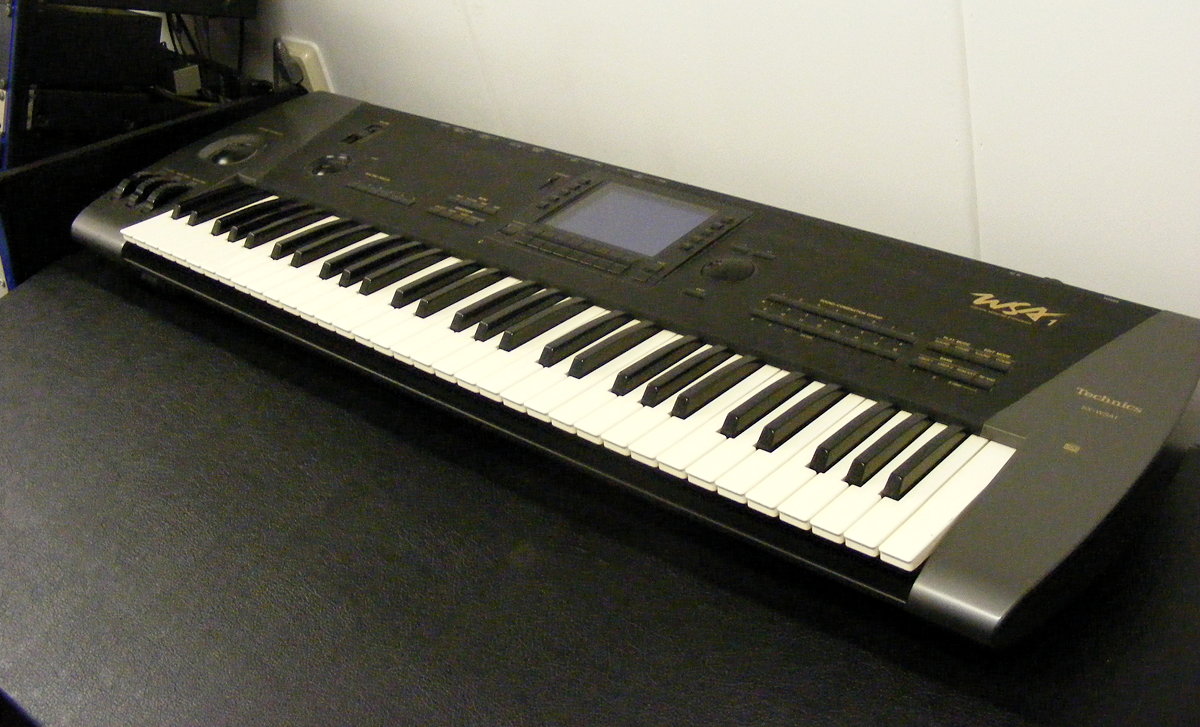 This is a very rare but beautiful virtual synthesizer and my new number 1 in the "Most Underestimated Synth Ever" contest. The WSA1 actually was the second virtual modeling synth to come on the market, after Yamaha's VL1 but before Korg's Prophecy. I read about it at the time but just like the Yamaha VL's, Korg Prophecy and later the Korg Z1 never came around to trying it. Now I am totally addicted. I even sold my Z1, which I thought I would never do. The genius of the thing is that they where able to combine the biggest advantages of physical modeling with a very flexible and rather accessible synth engine.
This is a very rare but beautiful virtual synthesizer and my new number 1 in the "Most Underestimated Synth Ever" contest. The WSA1 actually was the second virtual modeling synth to come on the market, after Yamaha's VL1 but before Korg's Prophecy. I read about it at the time but just like the Yamaha VL's, Korg Prophecy and later the Korg Z1 never came around to trying it. Now I am totally addicted. I even sold my Z1, which I thought I would never do. The genius of the thing is that they where able to combine the biggest advantages of physical modeling with a very flexible and rather accessible synth engine.
To never be out of a WSA again and to get hold of the SY-EW 1 expansion board I actually also bought the expander within a few months.
Then I added the Doepfer R2M ribbon controller (which see) and it became even better. It's bliss. If it only had polyphonic aftertouch and user sample loading. Then I would surely marry it. For now it will have to be contended with staying my secret mistress. But I am still almost sure it has replaced the CS80 as the best synth ever on my list. AND THAT MEANS A LOT!
Also see the Starship One project.
Waldorf Microwave XT
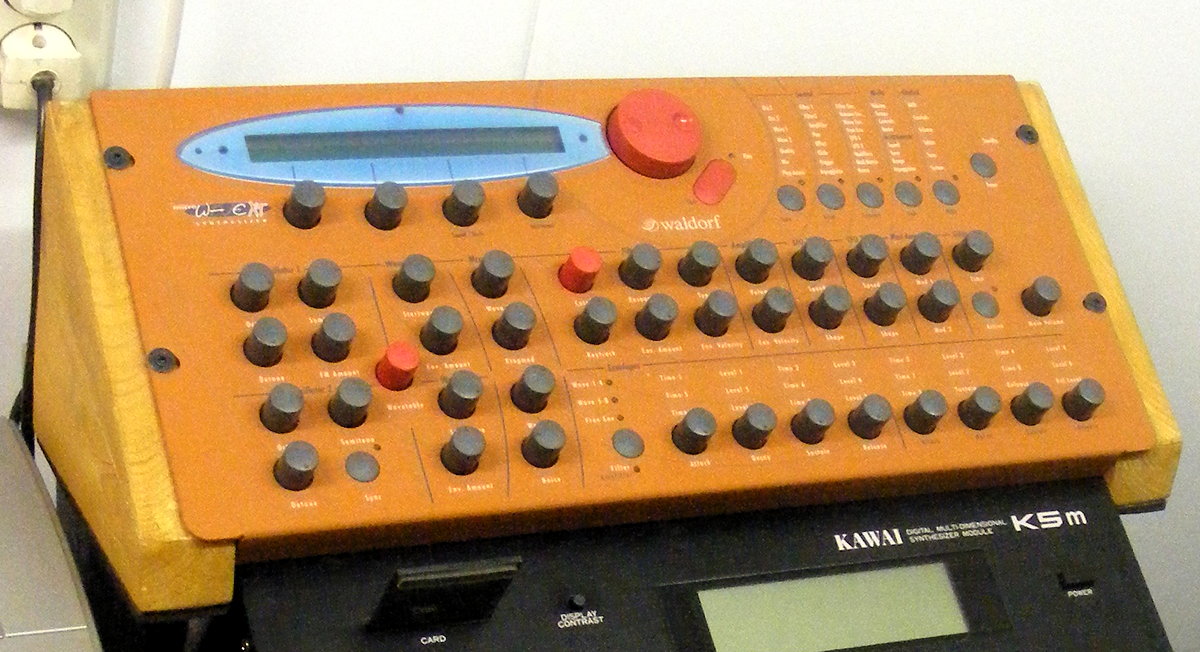 Wavetable synthesizer module derived from the old PPG's. Very versatile. Knobs enough but somehow still not as accessible as one might expect. A very complicated beast to program but it has that classic old PPG wavetable engine.
Wavetable synthesizer module derived from the old PPG's. Very versatile. Knobs enough but somehow still not as accessible as one might expect. A very complicated beast to program but it has that classic old PPG wavetable engine.
Wersi CX-5 drumcomputer
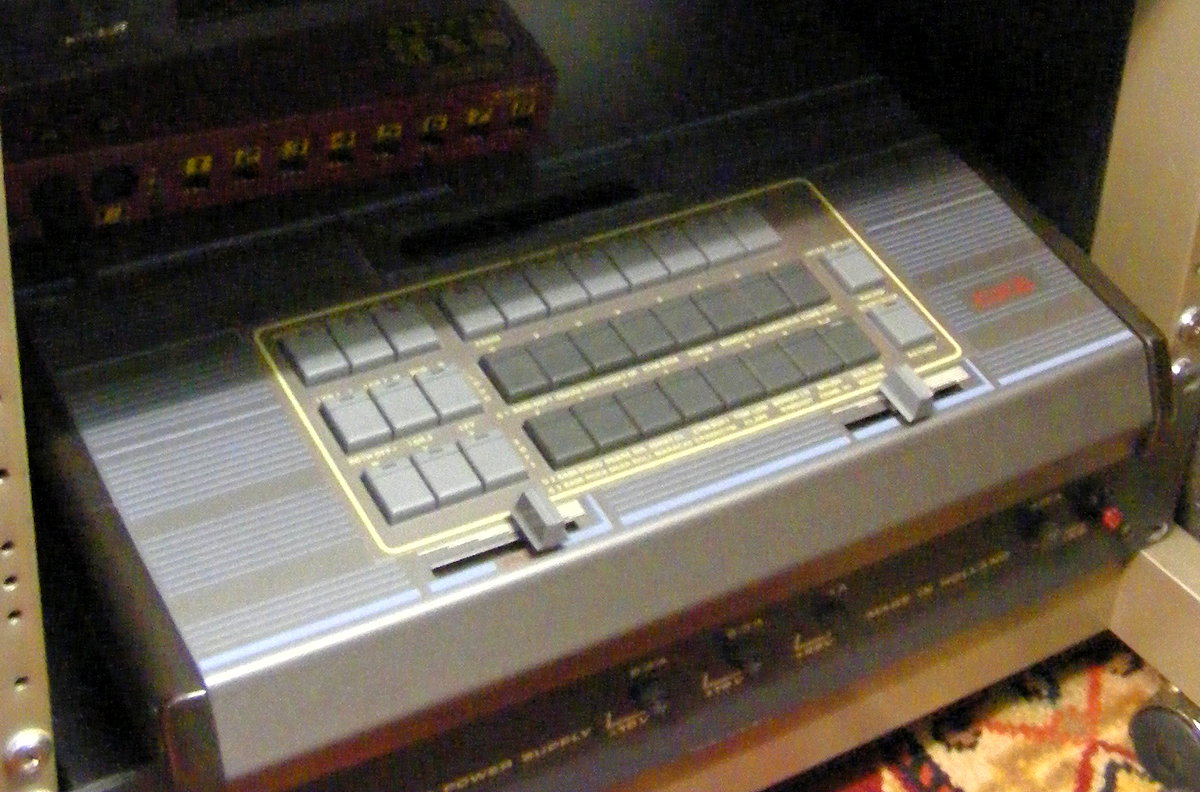 The first drumcomputer to combine a padinterface and MIDI into one package. I built it from a kit! The samples are only 8 bit but still sound very nice. I for instance still use one of the bass drums in my favorite acoustic drum sample set. And if you tune down the samples it get's this great grainy 8-bit sound. Instant industrial!
The first drumcomputer to combine a padinterface and MIDI into one package. I built it from a kit! The samples are only 8 bit but still sound very nice. I for instance still use one of the bass drums in my favorite acoustic drum sample set. And if you tune down the samples it get's this great grainy 8-bit sound. Instant industrial!
Yamaha TX-1P pianomodule
Older 12-bit piano sounds. It does however have more character then many modern sampled piano's. Especially the piano sound seems to have some acoustical room sampled into it. I used to mix it with my former Yamaha P80 to get a sort of best of both worlds. This set has now been superseded and surpassed by the GEM Promega 3 (which see) but I still have a weak spot for this old module. In it's time and within its limitations it served me very well.
Yamaha CS70M
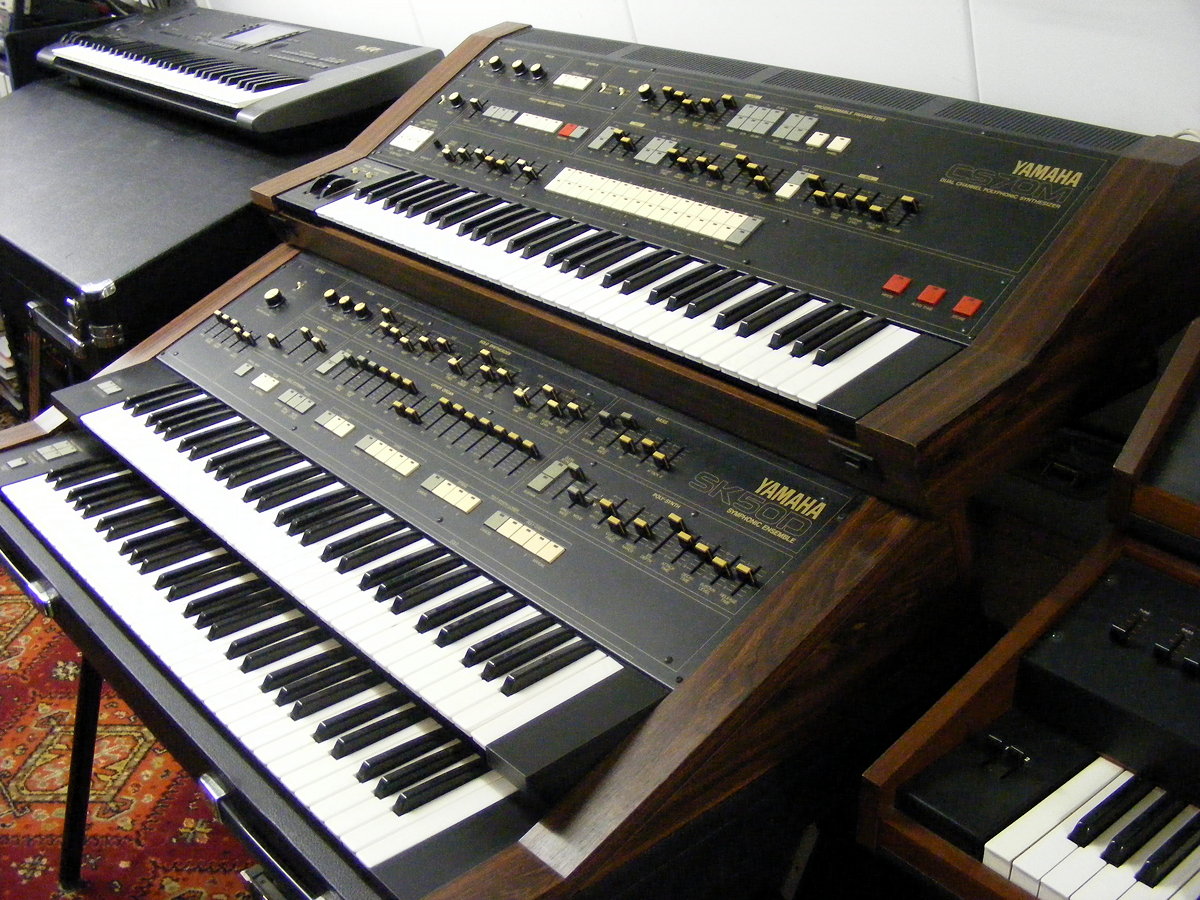 Not comparable to the CS-80 but very much underestimated.
Not comparable to the CS-80 but very much underestimated.
The CS70M is no CS80. It misses the velocity sensitivity, polyphonic aftertouch and pitch ribbon. Furthermore it's sound is more neutral and exact but also a lot less "creamy". At the time, after the success of the Prophet 5, it must however have seemed very logical to make these changes.
Judged on its own however the CS70 M is a very fine synth. Furthermore it is much more practical to own then a CS80. For those who really want to produce those typical CS80 sounds it can still be a good alternative. One only has to work a lot harder to reach a similar level of expression.
BEST FEATURE: The programmable LFO envelope generator, especially when combined with ringmod.
WORST FEATURE: The mono aftertouch always runs through the second, non-programmable LFO and can thus not control filter cutoff directly.
BEST TRICK: Always leave the mod wheel a bit open to use that very same second LFO as an overall constant modulation source. Then it really starts to breath and you can still throw ope the wheel further for more extreme effects.
Yamaha CS80
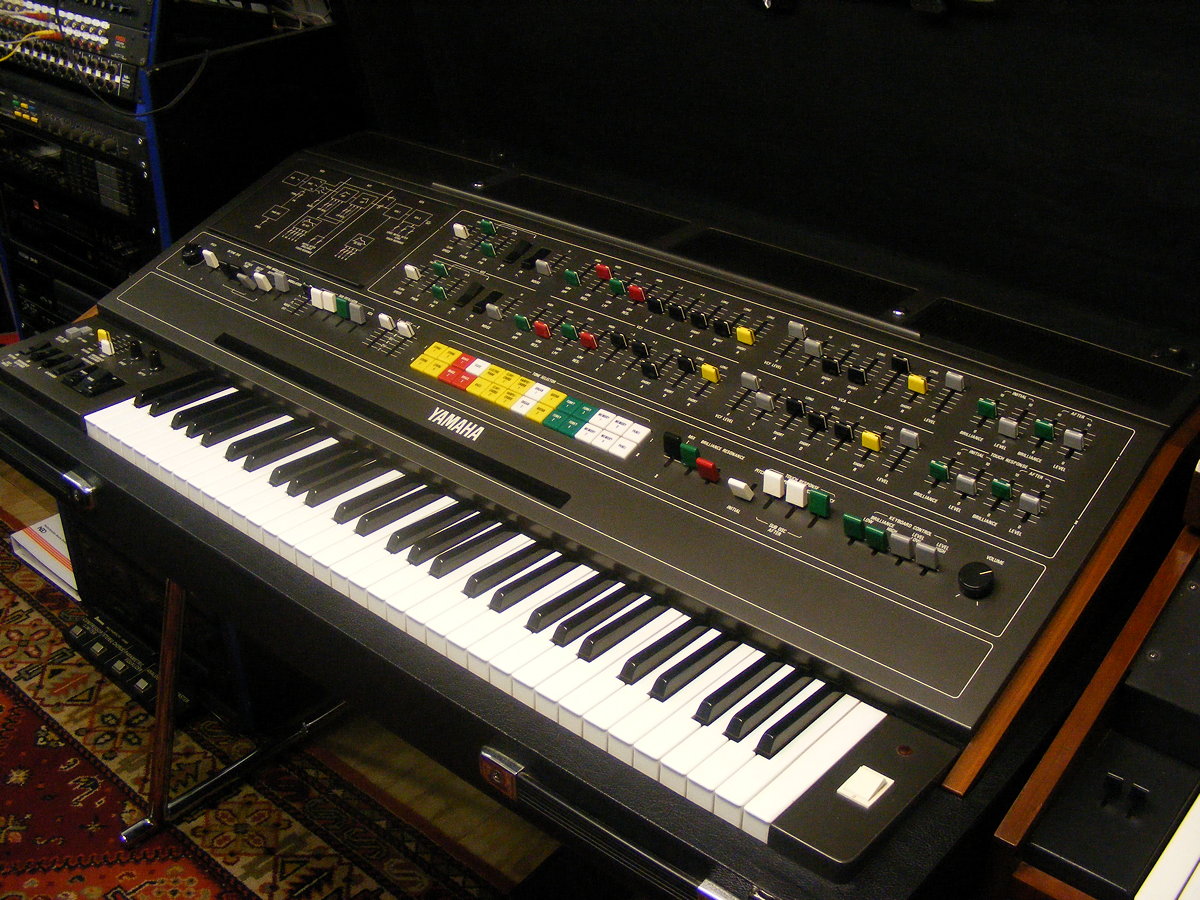 The Synth of synths! Nothing can beat it when it comes to polyphonic expression. As good as new. Saved from the cellar of a Munich Bavarian Oompah Music Studio years ago. I only paid Eu 2500,-- + travel expenses. God knows what I'd get for it now but to me it still is a real instrument and not an investment object.
The Synth of synths! Nothing can beat it when it comes to polyphonic expression. As good as new. Saved from the cellar of a Munich Bavarian Oompah Music Studio years ago. I only paid Eu 2500,-- + travel expenses. God knows what I'd get for it now but to me it still is a real instrument and not an investment object.
Yamaha E-70 organ
Also see the Son OF GX project.
Yamaha NS-10 monitors, Jamo SL 95 HIFI speakers with Alesis Ra 150 Amplifier
A good monitoring setup.
Yamaha PSR36
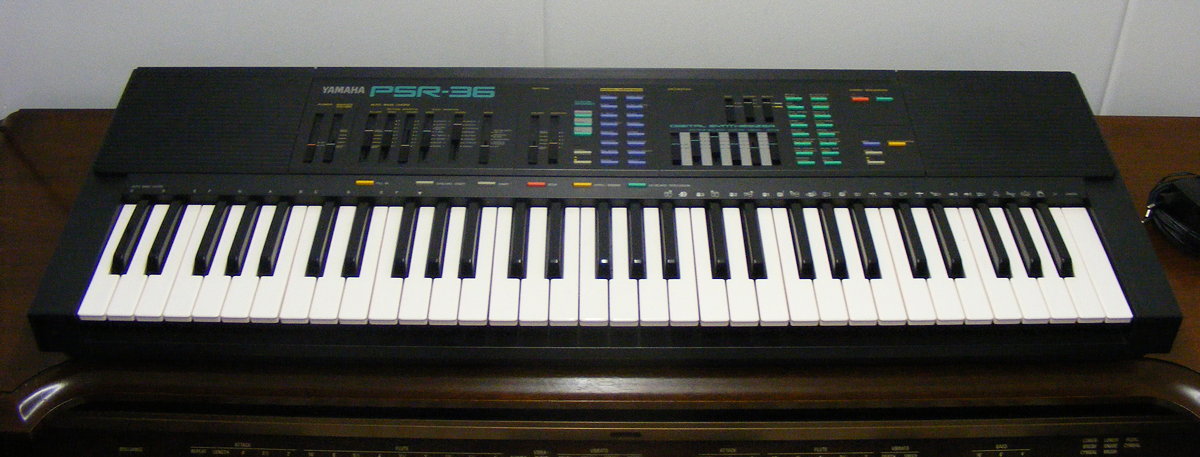 OK, that´s it! Adding more or less interesting organs could maybe be forgiven but home keyboards? In my collection? I would never have thought I´d ever see the day myself but the PSR36 has a very special trait.
That it is a FM synthesis instrument is not that special in itself. Yamaha inundated the world with variations on the theme. What I did however not know until rather recently is that certain Yamaha Portasound keyboards actually had rudimentary sound programming facilities!
OK, that´s it! Adding more or less interesting organs could maybe be forgiven but home keyboards? In my collection? I would never have thought I´d ever see the day myself but the PSR36 has a very special trait.
That it is a FM synthesis instrument is not that special in itself. Yamaha inundated the world with variations on the theme. What I did however not know until rather recently is that certain Yamaha Portasound keyboards actually had rudimentary sound programming facilities!
I once owned the first model of the DX7, so when it was still all the rage. I also programmed my own sounds on it. What else? In the end it however turned out that this was extremely rare. One can actually find a fair share of these unique FM-sounds on my early projects.
To trim an a possibly even longer story short: Although the DX7 was a versatile enough instrument I never liked its basic character. Too digital, too sinusy. So why bother with it´s unintuitive user interface any longer when sampling became affordable? And thus I never went back.
Until now. On the PSR36 one does not have to wade through endless menus to change a single parameter but simply choses a certain preset and can then influence its waveshape, brightness, attack, decay, sustain and vibrato settings, leading to many quite reasonable variations on Yamaha´s typical 4-operator FM sound (By the way: the DX7 had 6 operators).
Nice enough but still not spectacular one will say. When one however starts to to scroll through the low resolution parameters in real time something quite special happens. Suddenly the results reminded one of early PPG wavetable synthesizers like the 360 Wavecomputer (almost as if the similarity in the model number is not a coincidence!).
To be honest: Most people would not think about using it this way but I actually love such harsh, early digital sounds. Put some good spatial effects on them and they still sound like the future has at last come!
Once I knew about this system choosing between the PSR-36 and other incarnations of the design, like the PSS-480, was easy enough: The PSR36 is the only one with full size keys and MIDI.
Yamaha RY-10 drumcomputer
Although only 12 bit still an excellent source for reasonably realistic drum sounds.
Yamaha SK50D
Way back, when it was still in production, I immediately fell in love with this machine the first time I ever saw a photograph.
This one was a bit tatty when I bought it but after an optical and functional overhaul it now seems to be fully working, including the accompanying original bass pedals. Next step: To tie it to the CS70M via Yamaha's short lived, pre-MIDI, keycode system.
With a SK50D I can do about 70 % of what I can do on my CS80 for a fraction of the price. It really has that almost archetypal Yamaha analog sound. Add a good ring mod and you can increase that to 90 %!
Those are harsh words, especially from one of the biggest CS80 fans in the world but let's get real here: Organ, strings, polysynth and an expressive, aftertouch sensible solosynth are combined in one beautiful package. O.K. Of course that cannot compensate fully for the CS80's biggest assets (truly polyphonic compared to paraphonic, velocity sensitivity, poly aftertouch and pitch ribbon) but what price to pay for these extra facilities? Presently a decent SK50D or SK30 costs a twentieth of a CS80 and still they are more rugged and stable.
So get one while they're still a steal.